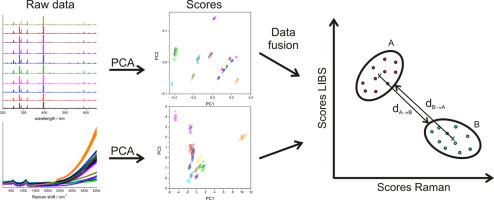Spectrochimica Acta Part B: Atomic Spectroscopy ( IF 3.3 ) Pub Date : 2021-04-14 , DOI: 10.1016/j.sab.2021.106198 Virginia Merk , Dominik Huber , Lutz Pfeifer , Saskia Damaske , Sven Merk , Wolfgang Werncke , Michael Schuster

|
Conjoint laser-induced breakdown spectroscopy (LIBS) and Raman spectroscopy and high level data fusion were used to discriminate sixteen different glass samples by principal component analysis (PCA). LIBS provides information on the elemental composition of a sample and Raman spectroscopy gives information about the molecular composition. The results were compared to single LIBS and Raman measurements as well as to μ-XRF and SEM-EDS which are also frequently used in glass analysis. The direction dependent Mahalanobis distance between the sample point groups in the space of the most significant principle components was evaluated as a criterion for potential discrimination of the different samples. Very good discrimination (up to 99%) was achieved with conjoint LIBS and Raman and high level data fusion, as well as LIBS alone. The discrimination is based primarily on different contents of trace elements (e.g., Fe, Ti, Ba, Sr), which was confirmed by the μ-XRF and SEM-EDS and differences in fluorescence (detected by Raman). Besides the similar discrimination power of LIBS and conjoint LIBS and Raman, the combination and fusion of LIBS and Raman leads to greater distances between the data in the principal component space due to the additional information added by Raman. This should result in a lower misclassification rate of unknown samples. Results show that conjoint LIBS and Raman spectroscopy can be an alternative in the forensic analysis of glass samples.
中文翻译:

结合拉曼光谱和激光诱导击穿光谱技术对汽车玻璃的区分以及多元数据分析
联合激光诱导击穿光谱法(LIBS)和拉曼光谱法以及高级数据融合技术通过主成分分析(PCA)来区分16种不同的玻璃样品。LIBS提供有关样品元素组成的信息,拉曼光谱提供有关分子组成的信息。将结果与单次LIBS和拉曼测量以及与μ-XRF和SEM-EDS进行了比较,后者在玻璃分析中也很常用。评估了在最重要的主成分空间中样本点组之间的方向相关的Mahalanobis距离,以此作为对不同样本进行潜在区分的标准。联合LIBS和拉曼以及高水平数据融合以及单独的LIBS可以实现很好的区分度(高达99%)。鉴别主要基于痕量元素(例如,Fe,Ti,Ba,Sr)的不同含量,这由μ-XRF和SEM-EDS以及荧光差异(由拉曼检测)证实。除了LIBS和联合LIBS与拉曼的相似识别能力外,由于拉曼添加的附加信息,LIBS和拉曼的组合和融合还导致主成分空间中数据之间的距离更大。这将导致较低的未知样本误分类率。结果表明,联合LIBS和拉曼光谱法可以替代玻璃样品的法医分析。除了LIBS和联合LIBS与拉曼的相似识别能力外,由于拉曼添加的附加信息,LIBS和拉曼的组合和融合还导致主成分空间中数据之间的距离更大。这将导致较低的未知样本误分类率。结果表明,联合LIBS和拉曼光谱法可以替代玻璃样品的法医分析。除了LIBS和联合LIBS与拉曼的相似识别能力外,由于拉曼添加的附加信息,LIBS和拉曼的组合和融合还导致主成分空间中数据之间的距离更大。这将导致较低的未知样本误分类率。结果表明,联合LIBS和拉曼光谱法可以替代玻璃样品的法医分析。



























 京公网安备 11010802027423号
京公网安备 11010802027423号